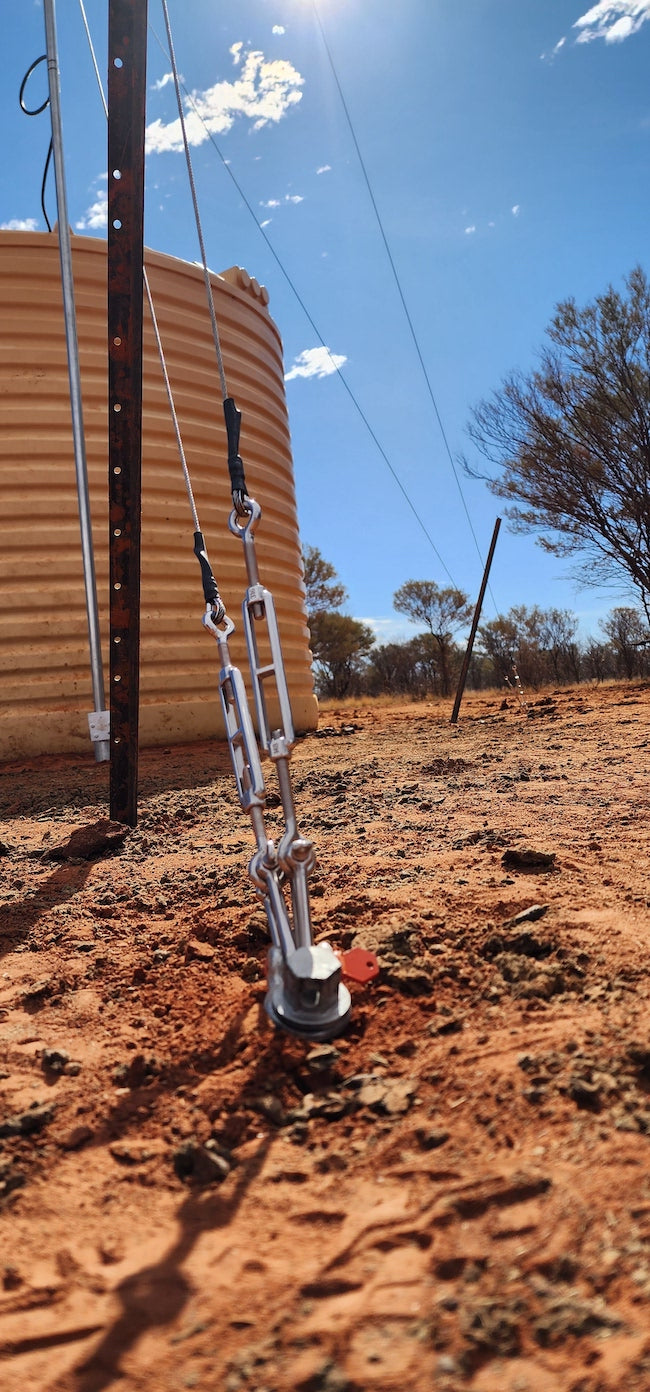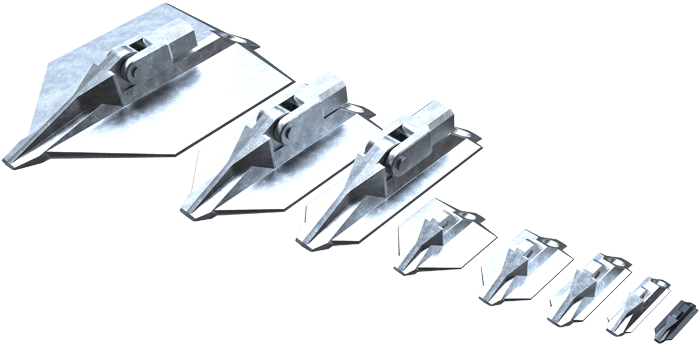Exactly How Heavy-Duty Earth Anchors Work: A Comprehensive Guide to Dirt Anchoring Solutions
Durable Earth supports play a vital function in giving stability and support in numerous building applications. By installing deeply into the ground, they resist vertical and side forces successfully. Various types of anchors deal with different soil conditions, making them functional. Recognizing their auto mechanics and installment methods is essential for taking full advantage of efficiency. What aspects influence their effectiveness, and exactly how do they compare to typical techniques? The answers might stun you.
Understanding Sturdy Earth Anchors
Sturdy Earth anchors work as crucial parts in various construction and landscaping projects, giving security and support in challenging soil conditions. These anchors function by being installed into the ground, where they withstand lateral and upright forces. Their design permits safe add-on to structures, ensuring they stay secured versus soil movement or exterior loads.The efficiency of sturdy Earth supports mostly relies on the sort of soil and the support's setup depth. Correct installment methods are essential, as they establish the support's holding capacity. Environmental factors, such as wetness and freeze-thaw cycles, can also impact performance.These anchors are frequently used in applications varying from safeguarding fencings and preserving wall surfaces to stabilizing short-lived structures throughout unfavorable climate condition. Comprehending the concepts behind durable Earth anchors is important for experts seeking to improve the durability and safety and security of their projects.
Types of Heavy-Duty Earth Anchors
Different sorts of heavy-duty Earth anchors are created to meet specific requirements based on dirt problems and task needs. Helical supports, including screw-like blades, work in softer dirts, supplying high lots capabilities and easy setup. Driven anchors, which are hammered into the ground, appropriate for rocky terrains and provide instant lots support. Tie-back supports are generally utilized in maintaining wall applications, enabling lateral support by anchoring into the ground at an angle. One more kind is the cast-in-place support, perfect for concrete applications, as they are incorporated right into foundations for boosted security. Dirt screw anchors are functional alternatives that can be utilized in different dirt types, offering reliable stress and compression abilities. Each kind offers distinct applications, making certain security and safety in construction and landscaping projects. Understanding these alternatives enables notified decisions in selecting the ideal Earth anchoring solution.
The Mechanics of Dirt Anchoring

Comprehending the technicians of dirt anchoring requires an assessment of different kinds of Earth anchors and their installation strategies. Each anchor kind offers distinct features that affect its effectiveness in various soil conditions. Appropriate setup approaches are important for optimizing the securing system's stability and efficiency.
Sorts Of Earth Anchors
Earth anchors, essential elements in soil anchoring systems, come in several types, each designed for details applications and soil conditions. One of the most common types include screw supports, which are turned right into the ground, offering strong lateral resistance. Helical supports feature blades that enable for effective installment in various dirt types, making them ideal for both short-term and irreversible applications. Driven anchors, typically made from steel, are hammered into the dirt and are efficient in thick or rocky settings. Auger anchors use a helical layout to facilitate setup in softer dirts. Plate supports consist of a level plate hidden horizontally, distributing lots over a bigger location, perfect for applications requiring high tons abilities in natural soils.
Installment Techniques Discussed
Proper installation strategies are important for the performance of dirt anchoring systems. The procedure normally begins with site assessment, verifying the chosen area can support the support's tons. After determining the appropriate anchor kind, proper opening deepness and angle should be established. The installation includes driving the anchor right into the ground utilizing specific tools, such as hand-operated or hydraulic vehicle drivers, to attain finest embedment. Post-installation, tensioning the support is essential to assure stability; this is frequently verified with load screening. Furthermore, bordering soil problems should be monitored to avoid displacement. Following these methods not just enhances the anchor's efficiency yet likewise lengthens its life expectancy, offering reputable assistance for various applications.
Applications of Heavy-Duty Earth Anchors
While heavy-duty Earth anchors are usually connected with construction and landscaping, their versatility encompasses a range of applications across different industries. In civil design, they offer important assistance for maintaining walls, making sure security in areas prone to soil disintegration. The aquatic industry makes use of these supports for protecting anchors and marinas, stopping motion brought on by currents and tides. In addition, in the telecommunications market, heavy-duty Earth anchors are significant for maintaining cell towers and other high frameworks versus wind pressures. Agricultural applications likewise profit, as these anchors can protect structures like greenhouses and livestock fence, ensuring they stand up to extreme climate condition. Furthermore, in sustainable energy tasks, such as wind farms, Earth supports play a crucial function in safeguarding wind turbine foundations, enhancing total security and performance. This broad variety of applications highlights the adaptability and reliability of sturdy Earth supports across different areas.
Advantages Over Conventional Anchoring Approaches
Although typical anchoring techniques have long been trusted for security, heavy-duty Earth supports provide considerable benefits that enhance performance and effectiveness. One major advantage is their exceptional load-bearing capability, which enables them to withstand higher pressures without failure. This stamina browse around this site makes them optimal for requiring applications, such as in building and energy installations.Additionally, durable Earth anchors are created for much deeper setup, offering greater security in numerous dirt conditions, consisting of sandy or loose soils. Their resistance to corrosion and environmental variables assures a much longer lifespan and lowered upkeep prices compared to conventional methods.Moreover, these anchors can be mounted with minimal disturbance to the surrounding area, maintaining the integrity of the landscape. On the whole, durable Earth supports offer a effective and reputable remedy for securing requirements, exceeding the restrictions typically related to conventional anchoring methods.
Setup Process and Best Practices
The setup process for dirt securing services starts with extensive preparation and site analysis to guarantee peak efficiency. Following this, a detailed setup overview gives clear instructions for effective execution (tensile load anchors). Complying with these ideal techniques is vital for attaining reputable and long-lasting anchoring results
Preparation and Site Analysis
Efficient preparation and extensive site assessment are vital actions in the installment of dirt securing solutions. Prior to installation, the dirt kind should be examined to identify its bearing capability and suitability for securing. Conducting a geotechnical survey can provide crucial details regarding dirt structure, wetness levels, and prospective ground movement. Additionally, recognizing existing structures, plant life, and utilities is vital to stay clear of interference during installation. The location should be cleared of debris and obstacles to ensure risk-free accessibility for equipment. Climate helpful hints problems should also be kept track of, as unfavorable conditions can influence both safety and installment efficiency. By meticulously preparing the website and examining all pertinent variables, the chance of successful anchor efficiency is considerably enhanced.
Step-by-Step Installation Guide
A complete setup process is crucial for accomplishing ideal performance of dirt securing options. The installation begins with choosing the appropriate anchor type and assuring the site is free from particles. Next off, appropriate hole positioning is determined based on load needs. When the area is established, openings are pierced to the defined depth and diameter using the right tools. The support is then put right into the hole, ensuring it is straightened properly. After safeguarding the anchor, dirt is backfilled and compacted to boost stability. It is necessary to comply with supplier standards throughout the process. A post-installation inspection validates that the anchors are effectively located and operating as planned, giving reputable support for the intended application.

Upkeep and Assessment of Earth Anchors
Normal maintenance and assessment of Earth supports are essential for ensuring long-lasting efficiency and security. Routine checks enable the early detection of issues such as corrosion, loosening, or dirt motion. Inspectors ought to try to find indications of rust or destruction on the support parts, especially at the connection points. Additionally, the bordering dirt must be evaluated for disintegration or modifications in moisture material, which can affect support effectiveness.It is recommended to develop a regular evaluation timetable, ideally at the very least yearly, relying on ecological conditions. Throughout examinations, all noticeable elements should be cleansed to remove dust or debris that might conceal possible problems. Any kind of signs of distress, such as turning frameworks or uncommon settling, need to trigger instant examination. Appropriate documentation of evaluations can assist in monitoring support efficiency in time and promote prompt upkeep activities, making sure the anchors continue to be practical and reliable.
Regularly Asked Inquiries
What Products Are Heavy-Duty Earth Anchors Usually Made From?
Durable Earth supports are typically constructed from durable products such as galvanized steel or stainless steel, making certain strength and resistance to rust. These products provide long-lasting support and stability in various dirt problems and applications.
How Do Soil Conditions Impact Support Efficiency?
Dirt problems substantially affect support efficiency. Aspects such as soil type, moisture content, and compaction influence the anchor's grip and stability, with cohesive soils frequently giving much better resistance than loose or sandy soils, impacting general effectiveness.
Can Heavy-Duty Earth Anchors Be Recycled After Removal?
Sturdy Earth anchors can be reused after removal, supplied they are examined for damages and wear. Correct cleansing and upkeep improve their durability, making certain reliable efficiency in succeeding setups when problems enable for secure reinstallation.
What Are the Ecological Impacts of Making Use Of Earth Anchors?
The environmental effects of utilizing Earth supports include prospective soil disruption, disturbance of regional ecosystems, and feasible contamination of groundwater. If made use of properly, their advantages usually surpass these issues, advertising security in numerous applications.
Just how Do I Choose the Right Support for My Project?
